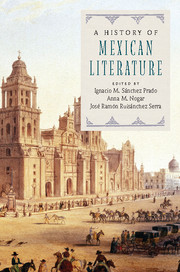Book contents
- Frontmatter
- Contents
- List of contributors
- Introduction
- PART I COLONIAL LITERATURE
- PART II THE NINETEENTH CENTURY
- PART III TWENTIETH AND TWENTY-FIRST CENTURIES
- 15 The Ateneo de la Juventud: The Foundations of Mexican Intellectual Culture
- 16 Regimes of the Avant-garde: Colonialists, Stridentists, Proletarians, Surrealists, Contemporáneos, and Independent Rupture (1920–1950)
- 17 The Institution of Fiction: From Yáñez, Rulfo, and Fuentes to Pitol and Del Paso
- 18 Octavio Paz: Literature, Modernity, Institutions
- 19 Mexican Poetry after the Avant-garde
- 20 Nonfictions: Essay, Criticism, and Chronicle
- 21 Balancing Acts: Twentieth- and Twenty-First-Century Mexican Theater
- 22 Women Writers in the Land of “Virile” Literature
- 23 The Hidden Histories of Gender: LGBTQ Writers and Subjectivities in Mexico
- 24 Mexican Literature in the Neoliberal Era
- PART IV MEXICAN LITERATURE BEYOND BOUNDARIES
- Index
- References
22 - Women Writers in the Land of “Virile” Literature
from PART III - TWENTIETH AND TWENTY-FIRST CENTURIES
Published online by Cambridge University Press: 05 July 2016
- Frontmatter
- Contents
- List of contributors
- Introduction
- PART I COLONIAL LITERATURE
- PART II THE NINETEENTH CENTURY
- PART III TWENTIETH AND TWENTY-FIRST CENTURIES
- 15 The Ateneo de la Juventud: The Foundations of Mexican Intellectual Culture
- 16 Regimes of the Avant-garde: Colonialists, Stridentists, Proletarians, Surrealists, Contemporáneos, and Independent Rupture (1920–1950)
- 17 The Institution of Fiction: From Yáñez, Rulfo, and Fuentes to Pitol and Del Paso
- 18 Octavio Paz: Literature, Modernity, Institutions
- 19 Mexican Poetry after the Avant-garde
- 20 Nonfictions: Essay, Criticism, and Chronicle
- 21 Balancing Acts: Twentieth- and Twenty-First-Century Mexican Theater
- 22 Women Writers in the Land of “Virile” Literature
- 23 The Hidden Histories of Gender: LGBTQ Writers and Subjectivities in Mexico
- 24 Mexican Literature in the Neoliberal Era
- PART IV MEXICAN LITERATURE BEYOND BOUNDARIES
- Index
- References
Summary
Rosario Castellanos closes her poem “Meditación en el umbral” with the oft-quoted line “otro modo de ser humano y libre / otro modo de ser” (another way of being human and free / another way to be) (1971: 316). Here she expresses a yearning for women to imagine another way of being beyond the time-worn scripts of exceptionality suggested by the female archetypes listed in her poem, including Sappho as well as Mary of Egypt. This yearning has been interpreted during many decades of the twentieth century as a kind of plaintive requiem for the absence of female voices on the national stage. It also resonates as critique – trenchant and incisive throughout Castellanos's work as a whole – of the deeply embedded patriarchal structures of Mexican society that relegated women for so long to paralyzing domestic roles. Her groundbreaking story “Lección de cocina” explores this dimension of female domesticity utilizing the German expression kinder, küche, kirche (children, kitchen, church) (Castellanos, 1971: 7) as a succinct summary of those gendered lived experiences. It is a truism to state that throughout most of Mexican literary history, the voices of women were at worst completely absent, and at best underrepresented or treated in a tokenistic fashion. Indeed, it has been commonplace in histories of literature in Mexico to acknowledge the importance of Sor Juana Inés de la Cruz, the “heroic foremother of feminist writing in Latin America” (Merrim, 2003: 39), and her philosophical contribution to the national literary tradition, while then skipping forward to those writers who have emerged strongly to transform the cultural sphere in the twentieth century. It goes without saying that there were women who wrote in the intervening centuries between Sor Juana, whose most influential text was published in 1691, and the twentieth century – when women's voices begin to be heard for the first time, claiming their place in the world of letters that had previously excluded them.
Before proceeding to examine those writers who have entered the cultural sphere in this timeframe, however, it is worth pausing for a brief theoretical consideration of the category of “woman writer,” which has been so central to feminist literary criticism.
- Type
- Chapter
- Information
- A History of Mexican Literature , pp. 338 - 349Publisher: Cambridge University PressPrint publication year: 2016



